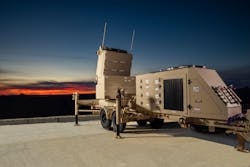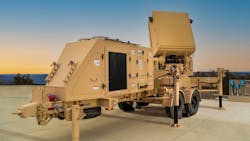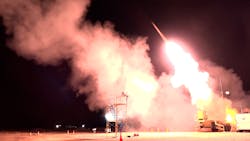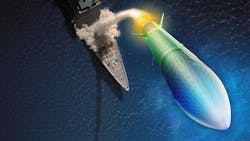The technological challenges of complex missile defense
By Megan Crouse
NASHUA, N.H. - Today’s long-range missiles require long-range defenses. Missile defense is a broad term for a wide variety of technologies and techniques. With some differences in place depending on the altitude of the threat, today’s missile defense is in effect an electronic blanket over ally nations. It consists of enabling technologies in four roughly divided use cases:
• detection
• tracking
• interception
• destruction
With so many moving parts, the number of enabling technologies also is large and complex. Much of the framework for missile defense is rooted in systemsNaturally, part of the challenge of missile defense the speed at which it must operate; it is a matter of split-second decisions. Defenders have exactly as much time as attackers. Missiles can travel across the world quickly, so detection must occur just as quickly. Detection and tracking both bring to bear electro optical sensors, radar, and more.
Interception, then, involves launching an anti-ballistic missile from a ground system, surface warship, or airplane. All can be differentiated based on range. The relatively well-known American Terminal High Altitude Area Defense (THAAD) system from Lockheed Martin Corp. has a range of several hundred kilometers and is suitable for a contested area or for underground military operations, while Raytheon’s PATRIOT anti-missile system has a relatively short range of 12 to 50 miles.
A multitude of enabling technologies are brought to bear here. Taken into consideration are the intercept vehicles themselves, their telemetry, high- and low-frequency radar, air and space-based sensors, infrared sensors, low-Earth orbit satellites, weather imaging, on-board processing, software, other sensors, and, potentially, artificial intelligence (AI).
The altitude of the threat also will depend on the situation. Different defenses account for the attacking missile at every phase of its flight, near the ground at launch and descent or in space during glide flight. The same system may be able to intercept at one or more of these altitudes. THAAD, for example, can do both, targeting short-, medium-, and intermediate-range ballistic missiles in their terminal phase with a kinetic warhead.
Another important factor: adversaries and allies alike are aware of defensive measures and try to counter them. Dummy missiles and signal-jamming techniques can confuse defensive strikes. If an ally aims for what appears to be a warhead only to hit an inert decoy instead, the defense will have failed.
THAAD and PATRIOT projects
The U.S. THAAD destroys incoming missiles using the kinetic energy of the interception impact, as opposed to an exploding warhead. This Army project is still well within its support lifetime, with Lockheed Martin Corp.’s Missiles and Fire Control segment in Dallas receiving a $74.1 million order from the U.S. Missile Defense Agency (MDA) in Huntsville, Ala. this April to build six launchers, THAAD Fire Control and Communication (TFCC) systems, and support equipment. THAAD has five major components carried on a four-axle heavy expanded mobility tactical truck:
• the launcher;
• the interceptor;
• radar;
• THAAD fire control and communications (TFCC) units; and
• support equipment
Inside that vehicle sit two mobile tactical operations centers (TOCs) and the system’s AN/TPY-2 ground-based radar (GBR). Each launcher takes about 30 minutes to reload.
Like other organizations we’ve talked about this year, the MDA is looking for projects to capitalize on Modular Open Systems Approach (MOSA), other open-The Army also uses the MIM-104 PATRIOT system (developed in collaboration between Raytheon, Lockheed Martin, and Boeing), which has served throughout U.S. and allied military operations since the 1980s. Originally intended primarily to shoot down aircraft, it now operates as an anti-ballistic missile system. PATRIOT is short for Phased Array Tracking Radar to Intercept on Target.
Army leaders are seeking a replacement for the PATRIOT system’s sensor, the Integrated Air and Missile Defense system. Specifically, Raytheon is contracted to provide the Lower Tier Air and Missile Defense Sensor (LTAMDS) radars. The Army will make a production decision in late 2023.
The Army also is reevaluating schedules for replacing the Lockheed Martin-made PATRIOT missiles, with a contract award to one vendor expected next year.
Aegis
Another major MDA project making headlines today comes from the Navy’s Aegis system. On July 1, MDA declared Lockheed Martin the recipient of a sole-source contract for Guam defenses, which also include Raytheon Technologies Standard Missile (SM)-3 and SM-6 missiles, and the Northrop Grumman Integrated Air and Missile Defense Battle Command System (IBCS) and the THAAD.
MDA officials say they do not anticipate revealing any more information about the project that might open it up to other possible contractors, but did hold an open call for interest until July 15.
The project will include the current Aegis weapon system common source library (CSL) software and production suites. It also involves developing a new launcher interface and non-recurring engineering and integration of a new launcher.
The GMD
The Army also fields the somewhat controversial Ground-Based Interceptor (GBI), a system which has been in place against potential attack on U.S. soil since the 1990s. GBI is part of the Ground-Based Midcourse Defense (GMD) system in place. It recorded a 50% kill rate in tests throughout its lifetime as of 2017. The interceptor component, known as the Exoatmospheric Kill Vehicle, fires a ramming missile into space to smash the target, with no warhead required. Its arsenal is generally regarded as having a sufficient number of missiles to defend against potential attacks from North Korea or Iran, while not enough to counter a wide-spread move by Russia or China.
One stepping stone to the next generation is the 2- and 3-Stage selectable GBI, which enables the vehicle to be released earlier than the previous version could be and saw a successful non-intercept test in September 2021.
Designs for the Next-Generation Interceptor passed a significant milestone in December 2021, with competing teams Lockheed Martin and Northrop Grumman both submitting systems requirements reviews. While details are slim on the requirements, Lockheed Martin talked up its digital twin system that aids in providing transparency and flexibility throughout the engineering process.
"This ‘fly-before-you-buy’ has already seen success in other military domains and we can leverage ‘e-fly-before-you-buy’ on NGI,” said Janica Cheney, director of Capability Implementation Management for Lockheed Martin.
Tracking missiles from space
Space-based early warning systems do not shoot down missiles but provide the first pieces of information when a missile reaches cruising altitude. Meanwhile, L3Harris is working on the Space Development Agency’s missile tracking project, a group of four satellites for Tracking Layer Tranche 0 under a $193 million firm, fixed-price contract.
The Tracking Layer Tranche 0 project, also developed with input and technology from SpaceX, is a Wide Field of View (WFOV) array intended to be able to provide missile tracking data for hypersonic glide vehicles and the next generation of advanced missile threats, according to Space Development Agency director Derek Tournear in Air Force Technology.
“They take data from multiple tracking systems, fuse those, and are able to calculate a fire control solution, and then the transport satellites will be able to send those data down directly to a weapons platform via a tactical data link, or some other means,” Space Development Agency director Derek Tournear said.
In particular, they’re looking for high-tech defense against hypersonic glide vehicles, which travel at speeds faster than Mach 5 and have low-heat signatures that make them hard to detect. Hypersonic glide vehicles also don’t follow the typical deterministic trajectory as other ballistic missiles, and can stymie software designed to predict missile targets based on their initial launch trajectories. A third challenge: how to handle simultaneous enemy missile launches.
“Rapid deployment programs, such as this one, demonstrate early missile warning and tracking missions can be efficient, affordable, and developed at a pace that keeps up with emerging threats,” said Ed Zoiss, president, L3Harris Space & Airborne Systems in a December 2021 press release. “L3Harris purchased subsystems and other material and began building while completing the design to demonstrate speed to deployment.”
Top-priority investments included enabling technologies such as spacecraft, payloads, ground software and advanced algorithms. L3Harris also is separately working on a prototype for the Missile Defense Agency’s Hypersonic and Ballistic Tracking Space Sensor (HBTSS).
“We observed that these instruments had the sensitivity and performance capability of detecting launches from orbit,” said John Holder, Missile Warning and Defense (MWD) chief systems engineer, L3Harris, in a press release. “This led to significant company investment to develop accompanying on-orbit algorithms that supported detection and tracking of these missiles through the multiple stages of flight and potential atmospheric conditions.”
Recently, L3Harris has been focusing on the detection and tracking phases of the MWD system architecture. This requires drawing from four main areas their enabling technologies need to cover:
• continuous global coverage;
• high sensory sensitivity and dynamic range, specifically in detecting light from dim to very bright;
• real-time, on-board processing that is capable of immediately detecting and tracking threats under a multitude of different geometries and atmospheric conditions; and
• open design architecture that supports rapid evolving performance in a schedule-driven, cost-constrained environment.
L3Harris engineers also are working on spinning out a proliferated low Earth orbit (pleo) technology centered around the MWD algorithm.
Northrop Grumman also is working on space-based missile tracking satellites to detect long-range, high-altitude threats. Company engineers can draw on a decade of experience with the demonstration Space Tracking and Surveillance System satellites, which were put in place in 2009 and retired in March 2022. Company officials say they plan to use the information learned from this early warning system for the company's next similar project, the Hypersonic and Ballistic Tracking Space Sensor (HBTSS) satellites.
Studies and criticism
There has been some public debate within agencies about whether space-based missile defense is the best course of action. A February 2022 report from theThe MDA and the Pentagon have pushed back against this idea. In particular, they suggest that external studies tend to rely on outdated information and cannot take classified data into account.
Hypersonic interceptor
Despite the concerns, the Missile Defense Agency is going ahead with plans to design and build a defensive hypersonic vehicle called the Glide Phase Interceptor, which would destroy adversary hypersonic missiles at speed during the unpowered portion of their flights. As of the contract announcement December 2021, the participating companies have until September 2022 to submit concept designs for prototypes.
This system would connect to the Navy’s Aegis cruisers, and will be designed to take advantage of the short window in which hypersonic missiles are in space, as well as to react to their ability to maneuver. While the radar on the Navy’s Aegis ships and the Sea-Based X-band Radar are suited for terminal defense, the HBTSS will cover tracking them through space after the boost phase.
On June 27, the MDA indicated only Northrop and Raytheon remain in the running for this project.
GhostEye
The Raytheon GhostEye family of missile defense radars is based on a project that Raytheon competed in the 2019 Army LTAMDS competition, which resulted in the company's selection by the Army to produce a next-generation sensor for lower tier air and missile defense. From there, the organization expanded variants of that radar into different products called the GhostEye family of radars, sharing commonality with LTAMDS.
GhostEye MR is a medium-range sensor that focuses on missile defense and air-breathing targets, which include fighter aircraft, cruise missiles, and unmanned aerial vehicles (UAVs), says Jeffrey Pellenz, Raytheon's associate director for GhostEye X and capabilities.
It connects to the National/Norwegian Advanced Surface to Air Missile System (NASAMS), a collaboration between Raytheon and Kongsberg Defence and Aerospace begun in the 1990s and now deployed in 12 countries.
Another one of the benefits of GhostEye MR is that it extends the kinematic range of those missile NASAMS fires, including the AMRAAM-ER, AIM-9X Sidewinder. It takes better advantage of those capabilities, which are also produced in-house, Pellenz says.
The NASAMS system has a longer view with these sensors, which gives the operator longer time against whatever mix of threats are coming their way. It’s giving them the tactical advantage by having that extended range. "There’s flexibility in what we can do because of the way we’ve designed the sensor,” Pellenz says.
Some of that comes from Raytheon’s ability to produce key components in-house. Company engineers make gallium nitride (GaN) chips, the component “at the heart of it all,” as Pellenz says, at a facility co-located with the rest of Raytheon’s manufacturing in Massachusetts.
“GaN allows us to improve our energy efficiency, so as much input power to output power as we can convert at a cleaner and more efficient rate. It allows us to improve range and sensitivity of the radar,” Pellenz said.
Making them in-house insulates this particular component from commercial market sources. It isn’t going to be influenced by shortages in the same market as laptop providers or other commercial tech.
“The reason we kept it in house was to ensure the high reliability our customers need. These radars go into diverse climates and are operating 24/7 around the world because of what they do and what they do it against. Having higher reliability and higher peak power is key,” Pellenz says.
Some of Raytheon’s work on LTAMDS and the GhostEye family of products is built on the organization’s experience with the PATRIOT system. They took what they already knew about more than 30 years of sensors in missile defense systems. Increasing the capability of the PATRIOT system in recent year has involved more hardware than it might in newer systems, but it also takes software updates in regard to the software-defined radars similar to the ones in the newer systems.
Currently, Raytheon is testing their first GhostEye MR system at the integration facility in New England after producing the first unit last year.
Electronics industry trends
In terms of the industry in general, Raytheon says organizations are looking for ready-now solutions in today’s world. "Past the capability of the system they’re looking for the ability to maintain it,” Pellenz says.
For Raytheon, that means developing augmented reality solutions to connect warfighters in the field to the organization’s experts to troubleshoot problems.
“It helps training, assists in keeping the readiness level up and is consistent with the users as the user community is very much of the gaming generation, so having training systems and sustainment technologies that mimic a gaming environment is something they’re familiar with and allows them to ramp up quickly,” Pellenz says.
Supply chain issues impact multiple industries
Supply chain issues are making headlines across industries. No one company took the brunt of the pandemic’s follow-on effects. Raytheon faced delays in the delivery of the LTAMDS program due to COVID-19-related system integration challenges and supply chain issues, but this is by no means an experience unique to the organization. Demand outpaces supply across the board, impacting suppliers’ ability to ramp up manufacturing, Raytheon representatives said in an email.
Meetings and partnerships seek to balance consumption and demand based on resource availability. Related U.S. Department of Defense initiatives also give organizations initial leverage when it comes to investing in domestic suppliers.
Semiconductors, steel and aluminum continue to be among the wide variety of materials and components affected by the ongoing effect of the COVID-19 pandemic on the supply chain.
The aerospace industry lost about 4 percent of its 2019 employees in 2020, more than 87,000 jobs, according to the Aerospace Industries Association. That means not enough people and not enough products.
John Mollard, acting chief financial officer for Lockheed Martin Corp., pointed out in an October 2021 earnings call that larger-than-expected supply chain problems stemmed from multiple suppliers -- particularly those that serve military and commercial aircraft. Fewer flights during the pandemic meant less cash for those companies. In response, Lockheed sent out accelerated payments to small- and medium-sized suppliers.
“We need our supply chain to be successful for us to be successful,” Mollard said.





